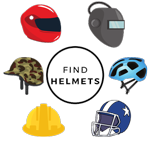Who Is Required To Wear A Bicycle Helmet
To ensure the safety on road, it is essential to wear a bicycle helmet. Those who ride their bicycles without a helmet are more likely to get head injuries. According to statistics, road-related collisions claim the lives of 800 cyclists yearly in the US. Because of a lack of compliance with bike safety regulations, most of them entail head and face injuries.
Who Must Wear A Bicycle Helmet
All bikers should wear helmets. Everyone riding should wear a bicycle helmet, regardless of age. The equipment will protect them in collisions or accidents, which may lower the incidence of fatalities involving bicycles.
Is A Helmet A Requirement For Bicycles?
City to city varies in its requirements for road safety. 22 states in the US have legislation requiring bikers to wear helmets when traveling on public roads. Bikers under the age of 18 or 16 are required by law to wear helmets when riding.
The minimum age varies from one state or city to another. For instance, California requires bike helmet use for those 18 and under, whereas West Virginia demands it for those under 15 years old. In New York, anyone under 13 must wear a helmet.
Also Read: Is A Motorcycle Helmet Bulletproof
Top Four Benefits Of Wear a Bicycle Helmet
Many people think that helmets are just for bikers, but this couldn’t be further from the truth. While helmets are essential for bikers, they are also crucial for anyone who rides a motorcycle, dirt bike, or any other type of motorbike. Here are the top four benefits of wearing helmets.
1. Helmets Guard Against Head And Brain Injuries
Wearing a helmet is essential for preventing fatalities and traumatic brain injuries (TBIs). It is the essential piece of equipment you can wear when you are out biking on the road. In the event of a collision or crash, this safety component can absorb the force of the impact. You are, therefore, less prone to sustain severe brain injuries, and it can cut the likelihood of a head injury in half.
Also Read: How Do Helmets Prevent Concussions
2. Wear a Bicycle helmet to increase your visibility.
When you are wearing a helmet while riding a bike in congested areas, drivers of cars can see you readily. Many helmets with vivid colors are made expressly for increased visibility.
With this gear, you may be instantly seen by drivers even at a greater distance. Helmets with integrated reflectors make you more visible even at night. A headlamp can also be mounted up front so you can see the road well.
3. Helmets Shield You From The Dust And Foreign Objects
Additionally, the helmet serves as protection from the elements. On a windy day, it might help keep your hair in place. So you won’t be distracted when riding by your hair. The foam layer’s composition can also keep your head warm on chilly days. In the summer, a helmet provides additional facial protection and shields you from UV radiation.
4. Helmets Shield You From Traffic Infractions
One of the most prevalent bicycle safety legislation is the need for helmet use. The laws requiring bicyclists to wear helmets vary by state, and bicyclists must follow these rules. For non-compliance, there are equivalent sanctions.
A good helmet is the best way to keep you safe on the road or trail. It’s a must-have piece of safety gear that can literally save your life. But with so many options available, how do you know which type of helmet to choose? Here are a few tips for buying a good helmet.
How To Choose A Good Helmet
A helmet should not be the primary safety concern for cyclists, and they should also confirm that the equipment complies with all necessary safety requirements. You must ensure that the bike helmet you select satisfies the Consumer Product Safety Commission’s safety requirements.
A high-quality helmet will have a label stating it underwent a rigorous quality check. You might also find the label on the chinstrap, exterior, or the lining inside the equipment.
Experts rate these Helmets with a safety designation for their protection, adaptability, comfort, and ventilation. Professionals perform thorough testing on the helmet’s buckles, connection points, and straps. They are then put to the test to see how they would fare in an accident. The gear is dropped onto a flat anvil at 14 mph throughout the test. Additionally, the testing process guarantees that the straps can hold the helmet in place even during an accident.
What Additional Considerations To Make
There are other elements you may take into consideration to purchase the best bike helmet in addition to the fundamental safety and passing the required quality checks.
1. MIPS-Equipped Helmets
Some helmets can reduce rotational force, reflecting how much your brain shifts inside your skull during an accident or collision. The multi-directional impact protection system, or MIPS, is present in this kind of helmet and may reduce the likelihood of a concussion.
A low-friction liner with the MIPS helmets reduces the amount of rotational force or energy that can get transferred to the head after a crash. According to reports, this low friction liner might cut the force by 43%.
2. Helmets With WaveCel Technology
The WaveCel technology included in helmets is an additional component to take into account. Gears utilizing WaveCel technology have a plastic layer within them. In the course of a collision or impact, the material may flex, crumple, or glide. It serves as a suspension system and deflects the impact of a collision.
Accidents can happen to anyone at any age. You should not make any compromises when it comes to safety. As a responsible rider, you should always wear a bike helmet, even if your city does not require it. We hope that this post about who needs to wear a helmet on a bike will motivate you to do so and reflect how important they are to your safety while riding.
Related Posts

